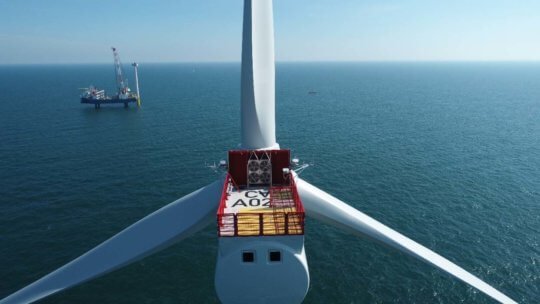(ARLINGTON, Va.) — Jennifer Carpenter, president and CEO of the American Waterways Operators (AWO), recently delivered remarks at American Clean Power’s Offshore Windpower Conference & Exhibition in Boston on facilitating investment in the fleet of vessels that will be necessary to support the expanding development of American offshore wind projects, as the United States accelerates its transition to offshore wind as a major renewable energy source.
Addressing an audience of offshore wind industry stakeholders as part of an Oct. 14 panel on “Spurring Investment in Offshore Wind Vessels,” Carpenter noted: “The (Biden) administration’s ambitious ’30 by 30′ goal is a generational opportunity for clean energy in this country and for American jobs. … We have the opportunity to work together to create the next great American industry with a made-in-America supply chain.”

Emphasizing that the domestic maritime industry is “ready, willing and able” to partner with offshore wind developers to build and operate vessels to support all phases of the offshore wind project life cycle, Carpenter highlighted four key steps to accelerate the process:
• To stimulate supply of American vessels, focus on demand. “A crucial next step is for businesspeople – wind developers and U.S. maritime companies – to get together and talk specifics: Here’s what I need, here’s when I need it, how can you help me do this as safely, efficiently and cost-effectively as possible? Those conversations are happening now and we need to have more of them, because eight- and nine-figure investment decisions get made when there’s a letter of intent, a contract, ‘take-to-the-bank’ assurance that demand exists to recoup investment in a long-lived asset.”
• Understand and acknowledge the ground rules, including the Jones Act. Explaining that legislation passed earlier this year explicitly clarifies that all U.S. laws, including the Jones Act, apply to renewable energy development on the Outer Continental Shelf, Carpenter noted: “The Jones Act governs the transportation of merchandise between U.S. points. … One important way to stimulate the construction of offshore wind vessels is to get busy talking with U.S. vessel owners about how they can build a U.S. vessel to meet your needs.”
• Share and spread business risk. “The simplest way to share business risk is a long-term contract,” Carpenter said.
• Collaborate to foster certainty and efficiency in the market. “A big part of creating the demand that stimulates investment in new vessels is getting offshore wind projects approved in a timely way, and I encourage you to think of the domestic maritime industry as your partners not only in developing vessel solutions to meet your logistics needs, but in bringing about this important new American market,” she said.
To learn more about the Offshore Windpower Conference & Exhibition, click here.
– American Waterways Operators
